|

AWM 067190 | Cowra POW camp, Cowra, New South Wales, 1 July 1944: A vegetable garden outside the mess building of the Japanese section of the 12th POW camp. This photograph, one of a series, was taken for the Australian Far Eastern Liaison Office for use in propaganda leaflets to be dropped over Japanese-held Pacific islands and the Japanese mainland. By mid-1944 approximately 1,100 Japanese POWs were being held in this camp. |
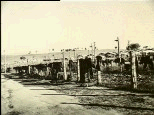
AWM 073485 | Cowra POW camp, Cowra, New South Wales, August 1944: Blankets thrown over the barbed wire by in B Camp, No. 12 Prisoner-of War Compound, by escaping Japanese POWs on the night of 5 August 1944. The POWs stormed the perimeter fences of the camp armed with improvised clubs and knives. Many escaped only to be recaptured over the following days. Of the 1,104 POWs in the camp 234 were killed in the break-out and 108 wounded. Four Australian camp guards were killed. (see also 068530) |
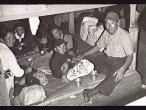
AWM 125635 | Port Melbourne, Melbourne, Victoria, 21 February 1946: A Japanese family in their cramped quarters aboard the Japanese ship Koyei Maru. The Koyei Maru, a former Japanese Imperial Navy minelayer and still crewed by Japanese naval personnel, was in Melbourne to repatriate approximately 2,800 Japanese civilians who had been interned in Australia during the Pacific war. |
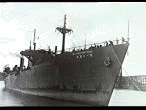
AWM 126101 | Balmain, Sydney, New South Wales, 2 March 1946: The Daikai Maru Osaka, the first Japanese merchant ship to enter Sydney Harbour since Australia and Japan went to war in December 1941. The ship is about to berth at No. 1 wharf where it will embark approximately 3,000 Japanese civilians and prisoners of war for repatriation to Japan. |
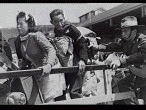
AWM 126300 | Balmain Sydney, New South Wales, 6 March 1946: Australian Military Police pushing a Formosan internee on to the Japanese repatriation destroyer Yoizuki. The internee was shouting: I am Chinese, I am not Japanese. |
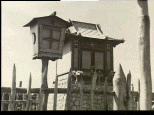
AWM 122997 | Barmera, South Australia, December 1945: The Japanese charnel house in 14 C Compound, No. 14 Camp, Loveday Internment Group. Inside the charnel house Japanese internees in this camp placed pieces of hair and fingernails from compatriots who had died in the camp. The box on the pole had hessian sides and a candle was lit inside. |

AWM 123016 | Barmera, South Australia, December 1945: Japanese clogs outside a hut in 14 B Compound, No. 14 Camp, Loveday Internment Group. Japanese internees always removed their footwear before entering the hut. |
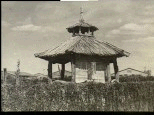
AWM 122995 | Barmera, South Australia, December 1945: The band rotunda at 14 C Compound, No. 14 Camp, Loveday Internment Group. Each day some Japanese internees could be found there playing bamboo pipes and stringed instruments. The original caption for this photograph described the hanging objects consisting of varying lengths of bamboo and glass which produced pleasant tinkling sounds in the wind. (wind chimes) |

AWM 064812 | Barmera, South Australia, March 1943: Japanese prisoners-of war placing offerings for the spirit of Matsujiro Nakayama, who died at the 14th Australian POW and Internment Camp, Loveday Group, South Australia. |
|